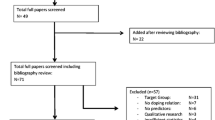Abstract
Religiousness is rarely studied in relation to doping behaviors in sport. In this study, we sampled 27 weightlifting/powerlifting athletes from Bosnia and Herzegovina. Using the originally developed questionnaire and by means of Spearman’s correlation, we interpreted data and discussed relationships between (a) social, religious, sport, and educational factors, and (b) substance use criteria, including cigarettes, alcohol, analgesics, nutritional supplementation, and doping behaviors. In conclusion, we found (1) that religiousness can be considered as a potential protective factor against doping, but also (2) that religious subjects tend to deny and underestimate the doping behaviors in their sport. Both of these findings should be extensively studied in future investigations.
Similar content being viewed by others
References
Alaranta, A., Alaranta, H., Patja, K., Palmu, P., Prättälä, R., Martelin, T., et al. (2006). Snuff use and smoking in Finnish olympic athletes. International Journal of Sports Medicine, 27, 581–586. doi:10.1055/s-2005-865826.
Auge, W. K., II, & Auge, S. M. (1999). Naturalistic observation of athletic drug-use patterns and behavior in professional-caliber bodybuilders. Substance Use and Misuse, 34, 217–249.
Backhouse, S., Mc Kenna, J., Robinson, S., & Atkin, A. (2007). International literature review: Attitudes, behaviours, knowledge and education—drugs in sport: Past, present and future. Prepared for WADA’s Social Science Research Fund (http://www.wada-ama.org/rtecontent/document/Backhouse_et_al_Full_Report.pdf).
Benzi, G., & Ceci, A. (2001). Creatine as nutritional supplementation and medicinal product. The Journal of Sports Medicine and Physical Fitness, 41, 1–10.
Blouin, A. G., & Goldfield, G. S. (1995). Body image and steroid use in male bodybuilders. The International Journal of Eating Disorders, 18, 159–165. doi :10.1002/1098-108X(199509)18:2<159::AID-EAT2260180208>3.0.CO;2-3.
Bray, S. R., Martin, K. A., & Widmeyer, W. N. (2000). The relationship between evaluative concerns and sport competition state anxiety among youth skiers. Journal of Sports Sciences, 18, 353–361. doi:10.1080/026404100402412.
Ghouri, N., Atcha, M., & Sheikh, A. (2006). Influence of Islam on smoking among Muslims. British Medical Journal, 332, 291–294. doi:10.1136/bmj.332.7536.291.
Islam, N., & Al Khateeb, M. (1995). Challenges and opportunities for tobacco control in the Islamic countries—a case-study from Bangladesh. Eastern Mediterranean Health Journal, 1, 230–234.
Kanayama, G., Barry, S., Hudson, J. I., & Pope, H. G., Jr. (2006). Body image and attitudes toward male roles in anabolic-androgenic steroid users. The American Journal of Psychiatry, 163, 697–703. doi:10.1176/appi.ajp.163.4.697.
Kanayama, G., Pope, H. G., Jr, Cohane, G., & Hudson, J. I. (2003). Risk factors for anabolic-androgenic steroid use among weightlifters: A case–control study. Drug and Alcohol Dependence, 71, 77–86. doi:10.1016/S0376-8716(03)00069-3.
Klein, H., Elifson, K. W., & Sterk, C. E. (2006). The relationship between religiosity and drug use among “at risk” women. Journal of Religion and Health, 45, 40–56. doi:10.1007/s10943-005-9005-6.
Lippi, G., Franchini, M., & Guidi, G. C. (2007). Tour de chaos. British Journal of Sports Medicine, 41, 625–626. doi:10.1136/bjsm.2007.035519.
Maravelias, C., Dona, A., Stefanidou, M., & Spiliopoulou, C. (2005). Adverse effects of anabolic steroids in athletes: A constant threat. Toxicology Letters, 158, 167–175. doi:10.1016/j.toxlet.2005.06.005.
Markovic, G., & Sekulic, D. (2006). Modeling the influence of body size on weightlifting and powerlifting performance. Collegium Antropologicum, 30, 607–613.
Menagi, F. S., Harrell, Z. A. T., & June, L. N. (2008). Religiousness and college student alcohol use: Examining the role of social support. Journal of Religion and Health, 47, 1–10. doi:10.1007/s10943-008-9164-3.
Merrill, R. M. (2001). Relationship between family religiosity and drug use behavior among youth. Social Behavior and Personality, 29, 347–358. doi:10.2224/sbp.2001.29.4.347.
Nagel, E., & Sgoutas-Emch, S. (2007). The relationship between spirituality, health beliefs, and health behaviors in college students. Journal of Religion and Health, 46, 141–154. doi:10.1007/s10943-006-9088-8.
O’Brien, K. S., Ali, A., Cotter, J. D., O’Shea, R. P., & Stannard, S. (2007). Hazardous drinking in New Zealand sportspeople: Level of sporting participation and drinking motives. Alcohol and Alcoholism (Oxford, Oxfordshire), 42, 376–382. doi:10.1093/alcalc/agm035.
Pipe, A., & Ayotte, C. (2002). Nutritional supplements and doping. Clinical Journal of Sport Medicine, 12, 245–249. doi:10.1097/00042752-200207000-00008.
Prendergast, H. M., Bannen, T., Erickson, T. B., & Honore, K. R. (2003). The toxic torch of the modern Olympic games. Veterinary and Human Toxicology, 45, 97–102.
Sekulic, D., Kostic, R., & Miletic, D. (2008a). Substance use in dance sport. Medical Problems of Performing Artists, 23, 66–71.
Sekulic, D., Kostic, R., Rodek, J., Damjanovic, V., & Ostojic, Z. (2008b). Religiousness as a protective factor for substance use in dance sport. Journal of Religion and Health (accepted) (e-pub ahead of print).
Sekulic, D., Males, B., & Miletic, D. (2006). Navy recruits; fitness measuring, validation and norming. Military Medicine, 171, 749–752.
Spanoudaki, S., Myrianthefs, P., Baltopoulos, P., Maridaki, M., Talmud, J., & Baltopoulos, G. (2005). Cigarette use among Greek athletes. Prevention and Control; the Official Journal of the World Heart Federation, 1, 229–236. doi:10.1016/j.precon.2005.09.002.
Storch, E. A., Kovacs, A. H., Roberti, J. W., Bailey, L. M., Bravata, E. A., & Storch, J. B. (2004). Strength of religious faith and psychological adjustment in intercollegiate athletes. Psychological Reports, 94, 48–50. doi:10.2466/PR0.94.1.48-50.
VonDras, D. D., Schmitt, R. R., & Marx, D. (2007). Associations between aspects of spiritual well-being, alcohol use, and related social-cognitions in female college students. Journal of Religion and Health, 46, 500–515. doi:10.1007/s10943-007-9119-0.
Acknowledgments
Damir Sekulic is an Associate Professor, University of Split, Croatia. Projects: Specific and situational measuring procedures in sport and kinesiology (funded by Croatian Government); Doping predictors in Croatia, Bosnia and Herzegovina and Slovenia (proposed for WADA funding). More than 30 times cited in the CC-SCI journals.
Author information
Authors and Affiliations
Corresponding author
Rights and permissions
About this article
Cite this article
Rodek, J., Sekulic, D. & Pasalic, E. Can We Consider Religiousness as a Protective Factor Against Doping Behavior in Sport?. J Relig Health 48, 445–453 (2009). https://doi.org/10.1007/s10943-008-9207-9
Received:
Accepted:
Published:
Issue Date:
DOI: https://doi.org/10.1007/s10943-008-9207-9




